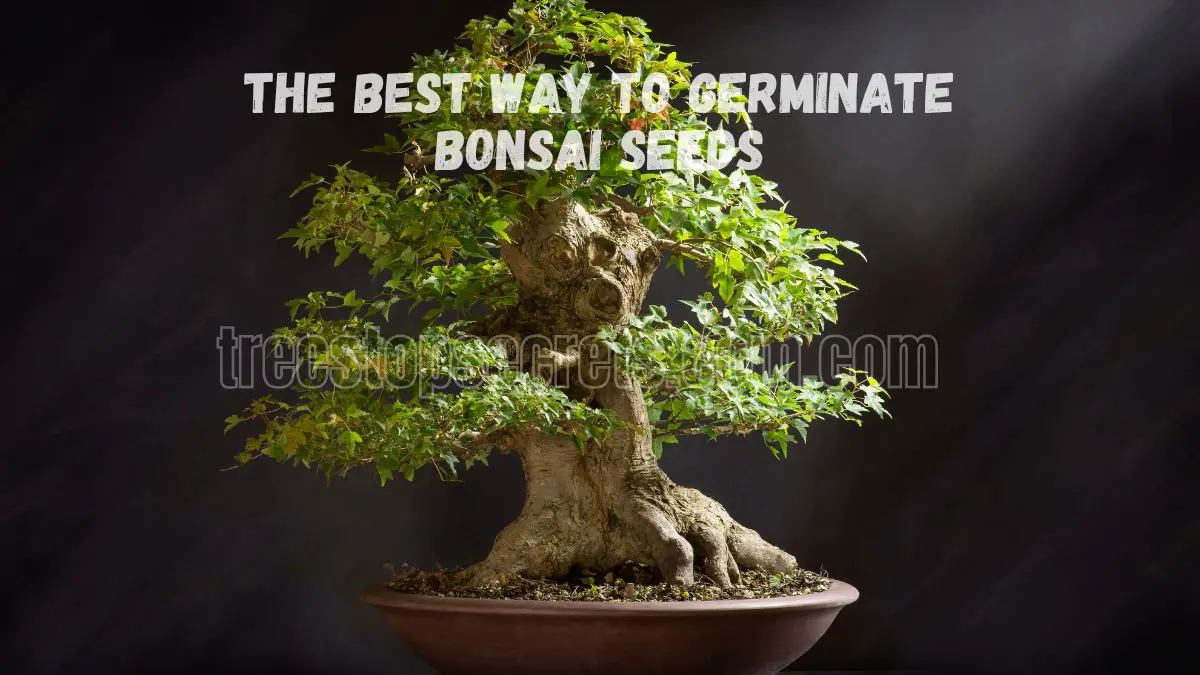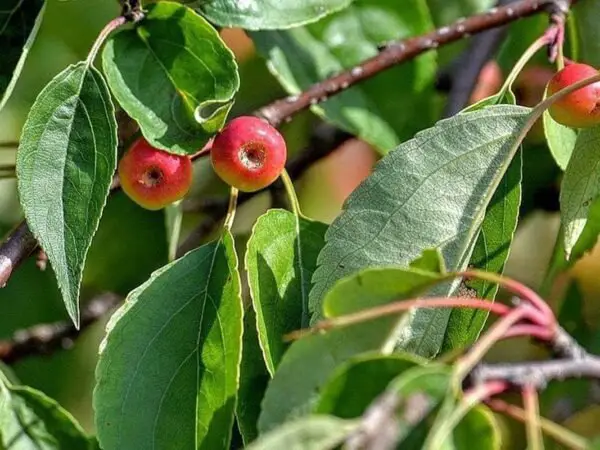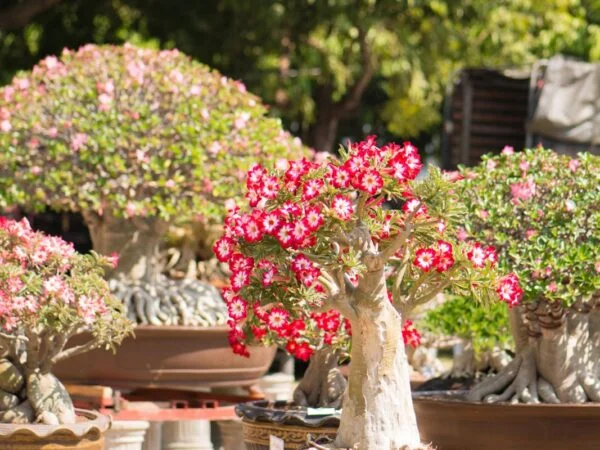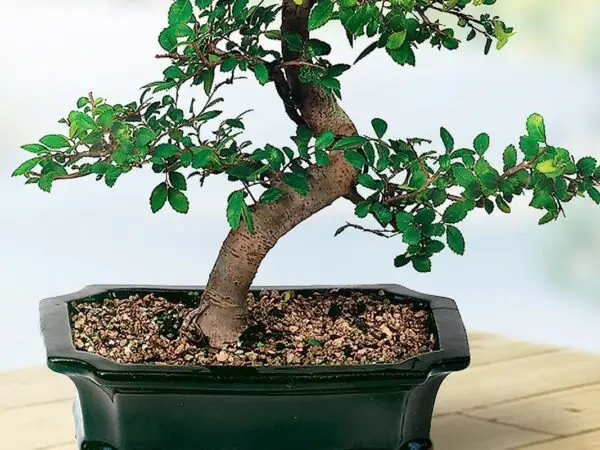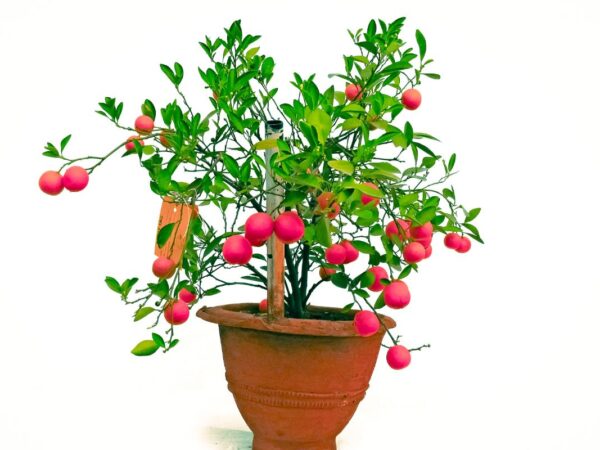First, soak your species of seeds in water for 24 hours to soften any hard outer shells. This helps cut down the length of time needed for germination.
Then, be sure to use a very light, well-draining potting mix and plant the seeds 1/4-inch deep. Providing even moisture is the key here, so you’ll want to mist the soil daily, keeping the soil moist but not soggy.
Put them somewhere warm and bright, around 70°F to 80°F is best, to help the seeds sprout. Once your seeds outgrow their starter cells, you can start hardening them, slowly acclimating them to outdoor conditions.
Complete these steps and you will have healthy seedlings, getting you off on the right foot towards your beautiful bonsai venture.
Key Takeaways
- Their lineage is an integral factor in determining the growth patterns and potential beauty of your bonsai tree. Armed with this information, you’ll be able to order the proper seeds to grow under your conditions.
- Selecting excellent quality bonsai seeds from trusted suppliers is crucial for successful growth and development of your bonsai tree. Learn which common species are best for beginners to get even more out of your bonsai experience.
- Properly seed for germination Make sure you have the right tools and supplies to properly germinate seeds, including seedling trays and specialty soilless seed mixes. Sterilizing your tools is essential to avoid any disease transfer, which can quickly kill your seeds.
- Learn about seed stratification methods, used to overcome seed dormancy and enhance germination. Adhering to these procedures will greatly improve your odds of a successful germination.
- To help seeds thrive, create the right environment by controlling temperature, moisture and light levels. Modifying these elements of the environment will help your tiny future bonsai flourish.
- Take proper steps to nurture your newly germinated seeds by adhering to an appropriate fertilization routine and transplanting methods. This way, you’ll catch any potential problems before they become major and allow for the healthiest, fastest growth possible.
Understanding Bonsai Seeds
Bonsai seeds are unique though. They are the beginning for crafting magnificent miniature trees that reflect beauty, patience and devotion. How bonsai seeds are different from ordinary seeds. These are typically trees that are well known for having smaller leaves, slower growth, and unique traits, which all lend well to being cultivated in the bonsai style.
Getting to know these seeds will help prepare any budding Bonsai enthusiast to begin this beautiful adventure!
What is a Bonsai Seed?
Bonsai seeds often have unique characteristics because they are collected from specific species, rather than common seeds. Secondarily, they frequently have genetics that predispose them to be able to hold size and shape through the years.
This genetic significance makes certain that the resulting bonsai seedling will have the potential to develop the aesthetic attributes desired. When a Japanese maple seed is planted, it can develop into an incredible tree.
With its stunning colors and elegant shape, it’s an ideal candidate for bonsai. The seed characteristics are very important to the successful growth and attractive appearance of the tree.
How to Choose the Right Seeds
When choosing bonsai seeds, think about their growth rate, climate adaptability, and your level of experience. It’s important to purchase seeds from well-known and respected suppliers who stand behind their quality.
A few popular bonsai species for beginners include:
- Ficus
- Juniper
- Chinese Elm
- Pine
Where to Source Bonsai Seeds
To start growing these miniature wonders, buy bonsai seeds at your local nursery or from an online seed vendor. Be sure to check for quality and viability before buying seeds.
Choosing the right climate evaluation considerations for seed packets is crucial. Climate considerations can help set you up for success when germinating bonsai seeds.
Preparing for Germination
Germinating bonsai tree seeds requires careful thought and planning. Before you dive in, ensure you have the right bonsai supplies and tools ready. This preparation lays the groundwork for optimal growth and prevents issues with young seedlings down the line.
Essential Tools and Supplies
As with any project, assembling the right tools is key. You’ll need some kind of seed trays or containers to hold the soil and seeds. A watering can will make it easy to moisten the soil without displacing or washing out your seeds.
High-quality soil mixes specifically made for bonsai cultivation are needed to provide the right nutrients. Cleaning up your tools and making sure everything is sterilized before use is key to avoiding diseases that can damage or kill seeds from germinating.
Essential Items:
- Seed trays or pots
- High-quality bonsai soil mix
- Watering can
- Labels for seed identification
- Sterilizing solution
Best Soil Mix for Germination
A conventional ideal bonsai soil mix consists of three equal parts akadama, pumice and lava rock. These materials provide proper drainage and aeration, both crucial for healthy root development.
The correct combination stops water from pooling, which could otherwise cause root rot.
|
Soil Mix |
Components |
Drainage Level |
Aeration Level |
|---|---|---|---|
|
Akadama |
Clay granules |
High |
High |
|
Pumice |
Volcanic rock |
Moderate |
High |
|
Lava Rock |
Porous volcanic stone |
High |
Moderate |
Ideal Timing for Sowing Seeds
Timing is everything when it comes to germination! Spring would generally be the ideal time of year to sow bonsai seeds, with milder temperatures and humidity more conducive to germination.
Keeping a close watch on local weather patterns will guide you in knowing the right time to sow, giving seeds the best chance to thrive.
Seed Stratification Techniques
Seed stratification is an essential technique that aids in the dormancy breaking of bonsai seeds so that proper germination can occur. This technique simulates natural winter conditions, a necessity for many seeds to initiate growth.
With the help of stratification, you can make a noticeable difference in your germination rates, giving your bonsai a healthy head start.
Methods for Cold Stratification
The most effective methods for cold stratification entail putting seeds in a moistened substrate and storing in a refrigerator. To process the seeds, first wash then soak the seeds in water for 24 hours.
Keeping the seed moist during this time is essential. Inability to control moisture conditions that are overly wet or excessively dry will leave you with an unsuccessful outcome.
Importance of Pre-Germination Treatments
Pre-germination treatments such as soaking and scarifying seeds improve their long-term viability and short-term growth potential. Soaking seeds in water helps to soften hard seed coats.
Meanwhile, scarification means nicking or scraping the surface of the seed coat to allow water to penetrate more readily.
- Soak seeds for 24 hours.
- Scarify hard-coated seeds with sandpaper or a knife.
- Keep seeds in a warm, dark place after treatment.
How to Soak and Scarify Seeds
Soaking seeds is a straightforward process. To soak seeds, put them in a bowl of water for one day, making sure they’re all covered by the water.
For mechanical scarification, you can rub seeds against sandpaper or use a knife to make small nicks in the seed coat. Equipment such as a hand file or portable seed scarifier are suitable methods.
Planting the Seeds
For bonsai seeds, successfully germinating them starts with the initial planting of viable seeds. This initial phase lays the groundwork for strong, healthy development of your beautiful bonsai tree, making it key to getting your seeds off to a great start.
Steps for Planting Prepared Seeds
To start, fill pots or trays with a seed-starting mix. Tamp the soil down hard to remove any air pockets. Then, water it gently so you’re soaking in the seeds and keeping the soil consistently moist but not wet.
Next, set the density dependent seeds onto the surface prepared, making sure they are separated in a wide manner. Sprinkle them with a very light covering of soil. About 1/8 inch deep should be enough to make sure they’re well protected, but not too deep.
After sowing your seed, mist the soil thoroughly and keep the soil misted to prevent drying out, which aids in the germination process.
Optimal Depth and Spacing for Seeds
The depth of planting depends on the type of seed used. For larger seeds, such as those from the banyan or Ficus tree, a depth of 1/4 inch is typical. Plant smaller seeds like the Japanese Black Pine much deeper, around 1/8 inch deep.
Spacing is very important. Seeds that are planted too close together can have to compete for nutrients and growing space. Space seeds at 2 inches in trays for adequate growth.
Plant seeds in a grid pattern across containers or fields, which helps bathe them in the light and airflow they crave.
Common Mistakes to Avoid
- Overwatering the seeds
- Planting too deep
- Crowding seeds together
Creating Ideal Growing Conditions
Setting up the optimum conditions is important for successfully growing bonsai tree seeds. Factors like temperature, humidity, light, and regular watering create the perfect breeding ground for optimal growth.
Maintaining Temperature and Humidity
The ideal temperature for germinating bonsai seeds is between 65°F and 75°F. Increasing and even warmth allows seeds to germinate and spring back to life.
To increase humidity, place a humidity dome over your trays or cover your seed trays with plastic wrap. This important step keeps your humidity levels as high as possible. Preventing drastic temperature changes is key, as rapid shifts can prevent adequate seed maturation.
Providing Proper Light Conditions
It’s important to note that bonsai seeds need bright, indirect sunlight in order to germinate properly. If you’re starting seeds indoors, grow lights can provide added light, so your seeds get the 12-16 hours of exposure they need every day.
If you have lots of natural light, consider setting your seed trays on or near a window. Just be wary of direct sunlight, as this may cause your seedlings to overheat.
Watering Techniques for Newly Planted Seeds
Correct watering technique is extremely important after sowing bonsai seeds. Don’t forget to use a spray bottle with light misting on your seeds to avoid displacing them from their nesting ground.
Inadequate watering is the number one cause of plant failure. Overwatering can cause root rot, and if you underwater them, seeds will dry out. A moisture meter does the best job of giving you an accurate reading on soil moisture levels.
Instead, choose watering cans that have long, narrow spouts for more targeted watering. Watch these conditions in detail to create the best possible conditions for successful germination.
Caring for Germinated Seeds
Young bonsai seedlings require special care to ensure they stay healthy and flourish. This would involve practices such as making sure they’re getting proper sun exposure, keeping the moisture levels in check, and using the right type of soil.
Seedlings are often delicate and should be watched carefully during their initial growth stages. Making alterations to your care routine as they grow will ensure your little seedlings continue on and become beautiful plants.
Fertilizing Young Bonsai Plants
An adequate fertilization regimen is of extreme importance. Start fertilizing your seedlings around the fourth to sixth week of germination, with a diluted liquid fertilizer.
Fertilize with balanced fertilizers, like a 10-10-10 NPK combination, to provide the nutrients needed. Avoid over-fertilization because it can cause root burn and make plants grow poorly.
Thinning and Transplanting Techniques
Thinning seedlings is a critical procedure to ensure robust development. As your seedlings get closer to two inches tall, thin the seedlings down so there’s about four inches of space between each plant.
Depending on how they germinate, seedlings should be transplanted into larger containers after they grow a sufficient root system, often three to four months old. To reduce transplant stress, be sure to avoid damaging roots and keep the roots moist, so as to not introduce additional stresses while transplanting.
Long-Term Care Practices
Continual care of germinated bonsai trees incorporates daily watering, pest control inspection, and gradual changes in lighting exposure. Consistent pruning and shaping are key to keeping your bonsai looking exactly how you want it.
Regular observation helps you identify problems as they arise, helping you nurture your bonsai into a magnificent and thriving tree.
Troubleshooting Common Issues
Bonsai seeds can be difficult to germinate for a number of reasons. Fortunately, knowing these common issues will help you to take preventive action, paving the way to a much more successful growth process.
Identifying symptoms of poor seedlings is crucial. Healthy seedlings are usually apparent, displaying dark green or blue-green foliage, vigorous plant growth, and low wilting. These are telltale signs of common problems including overwatering, lack of light or nutrient deficiency.
Reasons for Poor Germination Rates
There are a number of reasons that bonsai seeds may not germinate well, primarily seed viability and environmental factors. High quality seeds are very important to successful germination.
Old or poorly stored seeds may not germinate. Insufficient temperature or humidity can throw a wrench in the operation. The perfect conditions for the majority of bonsai seeds is generally around 65°F to 75°F accompanied by even moisture.
Once you have the right seeds, following best practices for preparing to plant them, like soaking seeds before you sow, can dramatically increase your odds of succeeding.
Solutions for Seedlings Not Thriving
If your seedlings aren’t making the grade, here are some practical remedies you can take. First, take stock of your light situation. Seedlings need a lot of bright, indirect light—your setup may not be ideal so be prepared to move them around or invest in grow lights.
Watering practices—especially frequency, depth, and timing—are just as critical. Be sure to keep the soil evenly moist, but not waterlogged. Nutrient amendments are another way to improve seedling condition.
A diluted liquid fertilizer can add both N and P. By keeping a careful watch on growth trends, you can spot critical issues before they worsen and be better positioned to take fast action.
Advantages and Disadvantages of Seed Propagation
Seed propagation transcends bonsai cultivation to a higher level. Enthusiasts will be able to experience and appreciate the entire growth process right from the beginning. This method has a distinct advantage over other propagation methods such as cuttings or air layering.
Certainly, each propagation method has its advantages, but seed propagation offers unique benefits that are important to consider.
Benefits of Growing Bonsai from Seeds
One big advantage of starting from seeds is genetic diversity. This diversity results in extraordinary trees that embody the desires of their planters and the culture of their underlying soil.
There’s an incomparable joy in raising a tree from seed to adulthood. From germination to harvest, every phase of development deepens your relationship with the plant, creating an incredible bond.
When starting from seeds you have greater control over the finished shape and style. You can influence what direction it grows in and how many branches it develops. This means you can create a truly unique bonsai that is more representative of your dreams.
Challenges Compared to Other Methods
Growing bonsai from seeds has a lot of difficulty. The timeline is much more extended than other methods, often decades before being able to see a mature tree.
The trials of seed germination and early stages of care can be overwhelming. You’ll need to keep a close eye on moisture levels, temperature and light conditions to promote healthy sprouting.
This process requires time and dedication. There’s a lot of work that you’ll have to put in up front before the fruits of your labor can really be harvested.
|
Pros of Seed Propagation |
Cons of Seed Propagation |
|---|---|
|
Genetic diversity |
Longer timelines |
|
Control over shape/style |
Complex germination process |
|
Personal connection to growth |
Requires patience and commitment |
Transitioning from Seedling to Bonsai
Germinating bonsai seeds and nurturing them into established bonsai trees is a rewarding process that takes time and experience. Knowing the key stages of development is very important. As soon as that seedling breaks ground, you will experience that seed’s journey through several more stages.
These stages are the seedling stage, early development, and then the creation of a wonderful bonsai. Every detail matters, but that’s each step in the process right down to creating a stunning and resilient tree.
Key Steps in Developing a Bonsai Tree
Training and shaping young bonsai training is an important process. First, it’s important to choose the appropriate container and media, allowing for proper drainage and air exchange.
Once those seedlings take root, creative and consistent pruning will be essential to keep them small and maximize their branching. Wiring, perhaps the most critical bonsai technique, gives you the ability to bend and train branches into positions you want, creating the framework of your tree.
Keeping a regular schedule of maintenance, from watering to keeping an eye on light exposure, is vital throughout the growing process.
Aesthetic Considerations in Bonsai Design
The artistic elements of bonsai design have a major impact on how a tree is grown. Aesthetics often lead decisions on how to prune and shape.
For example, creating a naturalistic and harmonious appearance might dictate branch lengths, thickness, and angles. Producing nice looking arrangements quickly from a seedling just as needing an eye for scale and spacing.
Look for ways to incorporate other plants or hardscape materials, like rocks, that will help showcase the miniature landscape.
Conclusion
After all, there’s nothing more gratifying than planting your own bonsai seeds and watching them grow. You develop a greater appreciation for your plants, and cultivate the virtues of patience and care. Complete the simple steps below to successfully prepare and grow your seeds. From knowing what your seeds need to make them germinate to providing the right conditions, every step of the process counts. By working through these points, you can produce vigorous, sturdy seedlings. Just keep in mind, each bonsai starts out as a small seed, and with the proper care and love, it will flourish. Relish the process as you cultivate your bonsai from a simple seed to a stunning masterpiece. So begin your bonsai journey today, and take on the challenge and wonder of growing your own trees from seed. Then your work will result in a beautiful reward that you can enjoy for years to come.
Frequently Asked Questions
What is the best way to germinate bonsai seeds?
Combining seed stratification with optimal growing conditions, including bonsai tree seeds preparation, moisture, and temperature control.
How long does it take for bonsai seeds to germinate?
Time for germination varies by species, especially with bonsai fruit tree seeds, but often takes from 2 weeks to many months. Ensure you provide seeds the optimal conditions they need to sprout.
Do I need to stratify bonsai seeds?
Yes, nearly all bonsai tree seeds require some form of stratification, replicating a real winter to improve germination success by breaking dormancy effectively.
What soil is best for bonsai seed germination?
Creating a well-draining soil mix is essential for germinating bonsai tree seeds. By making an even mixture of peat moss, perlite, and sand, you can achieve good aeration and moisture retention.
How often should I water germinating bonsai seeds?
Maintain a regular moisture level without oversaturating your bonsai fruit tree seeds. A watering every few days will be adequate to stay moist, varying based on your humidity and temperature.
Can I use regular potting soil for bonsai seeds?
Regular potting soil won’t work to germinate bonsai seeds. Choose a fine-grained, specialty bonsai soil mix that encourages good drainage and root rot freedom.
What should I do if my bonsai seeds don’t germinate?
If your bonsai seeds aren’t germinating, examine the moisture, temperature, and stratification methods being used, as specific seeds may require special treatment or optimal growth conditions to sprout properly.
Image Source: Paid image from CANVA

